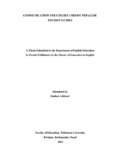Please use this identifier to cite or link to this item:
https://elibrary.tucl.edu.np/handle/123456789/1850| Title: | Communication Strategiesused by Nepalesetourist Guides |
| Authors: | Adhikari, Madhab |
| Keywords: | Human Communication;Nepalese Tourist |
| Issue Date: | 2014 |
| Publisher: | Faculty of Education |
| Abstract: | This study entitled"Communication StrategiesUsed by Nepalese TouristGuides"is an attempt to find out the types and frequencyof communicationstrategiesusedby Nepalese tourist guidesalong with the relationshipbetweentheir language exposure and the choiceofparticularcommunication strategy.This study was carried out using both primary and secondary sources of data. Iobserved and interviewed 30 tourist guides working in different places ofKathmandu and Lalitpur districts.Theywere selected through purposivesampling procedure. I observedthe conversationand recordedthem in theobservationtable. The collecteddatawas analyzed and interpreted to find outthe types and frequency of communication strategies used by them. It wasfound thattheyusedten different strategies:foreignising, paraphrase,approximation, word coinage, restructuring, topic avoidance, messageabandonment and message reduction. Among these strategies, the mostfrequentlyused communicationstrategywas paraphrase. It was also found thatthe guides who had more exposure to spoken languageused more L -bsaedstrategies such as literal translation, language switch, whereasthe guides whohad comparatively lessexposure usedmoreL -bsaed strategiessuch asparaphrase,approximation, etc. ix 1 This thesis consistsoffourchapters.The first chapterdeals with theintroductionpart which includes general background, types of humancommunication, origin of the concept of communication strategy, definition ofcommunication strategy,communication strategies as strategic competence,major aspects of communicationstrategy, learningstrategies, communicationstrategy Vs learning strategy,review of the related literature, objectivesof thestudyandsignificance of the study.The second chapter deals with themethodology used in the study. The sources of data, samples, and samplingprocedure, tools for datacollection, procedure and delimitations are included inthis chapter. Chapter three includes analysis and interpretation of data. Finally,chapterfour includes the findings and recommendations. |
| URI: | http://elibrary.tucl.edu.np/handle/123456789/1850 |
| Appears in Collections: | English Language Education |
Files in This Item:
| File | Description | Size | Format | |
|---|---|---|---|---|
| cover.pdf | 42.37 kB | Adobe PDF |  View/Open | |
| chapter.pdf | 356.02 kB | Adobe PDF |  View/Open |
Items in DSpace are protected by copyright, with all rights reserved, unless otherwise indicated.
